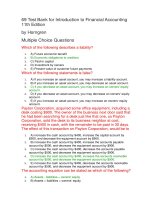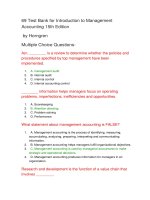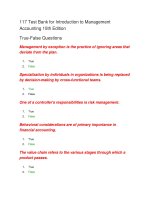Download test bank for introduction to global health 2nd edition jacobsen
Bạn đang xem bản rút gọn của tài liệu. Xem và tải ngay bản đầy đủ của tài liệu tại đây (123.87 KB, 6 trang )
Test Bank for Introduction to Global Health 2nd Edition
Jacobsen
Sample
Chapter 14
Multiple Choice
1. Which of the following statements is not included in the Preamble to the
Constitution of the World Health Organization?
A. Governments have a responsibility for the health of their peoples
B. The enjoyment of the highest attainable standard of health is one of the
fundamental rights of every human being
C. The health of all peoples is fundamental to the attainment of peace and security
D. Unequal development in different countries in the promotion of health and control
of diseases is a common danger
E. All of these statements are part of the WHO Constitution
Ans: E
Page: 336
2. Which of the following is not included in the Universal Declaration of Human
Rights
A. The right to freedom from slavery and servitude
B. The right to freedom of peaceful assembly and association
C. The right to privacy
D. The right to rest and leisure
E. All of these statements are part of the UDHR
Ans: E
Page: 337
3. Which of the following is not included in the Universal Declaration of Human
Rights
A. The right to education
B. The right to freedom from torture
C. The right to marry and found a family
D. The right to own property
E. All of these statements are part of the UDHR
Ans: E
Page: 337
4. Which of the following criteria is not used to evaluate whether a population has at
least minimal access to health care?
A. Health care facilities must be adequately stocked with necessary supplies
B. Health care facilities must be physically accessible to everyone, including people
with disabilities
C. Health care providers must be respectful of patients, including those from diverse
cultures
D. Health care services must be free to the user
E. All of these conditions must be in place to meet the minimum standard of access
to health care
Ans: D
Page: 340
5.
A.
B.
C.
D.
About how much does it cost to create and test one new medication?
$500,000
$1 million
$100 million
$1 billion
Ans: D
Page: 340
6. About 16% of the world’s population lives
in a high income country.
Approximately what percentage of pharmaceutical sales are made in high income
countries?
A. 20%
B. 40%
C. 60%
D. 80%
Ans: D
Page: 344
7. About 18% of the world’s population lives in a low income country.
Approximately what percentage of pharmaceutical sales are made in low income
countries?
A. 1%
B. 5%
C. 12%
D. 20%
Ans: A
Page: 344
8. Which of the following is not considered to be a critical need immediately
following a natural disaster or other humanitarian incident?
A. access to communications technology
B. essential health services
C. food and shelter
D. WASH (water, sanitation, hygiene)
E. All of the above are considered to be critical needs
Ans: A
Page: 347
9. Which of the following people would notbe considered to be a refugee?
A. A person who has moved to another country because of civil conflict
B. A person who has moved to another country because of political persecution
C. A person who has moved to another country for economic opportunities
D. A person who has moved to another country to escape ethnic-based violence
E. All of the above would be considered refugees
Ans: C
Page: 350
10. Which of the following people would be considered to be a refugee?
A. A person who has moved from a rural area to the national capital because of a
natural disaster
B. A person who has moved from a rural area to the national capital to avoid civil
conflict
C. A person who has moved to another country for education
D. A person who has moved to another country to escape religious persecution
E. None of the above would be considered refugees
Ans: D
Page: 350
11. Which United Nations agency has special responsibilities for education, nutrition,
and water/sanitation during international humanitarian responses?
A. UNDP
B. UNHCR
C. UNICEF
D. WHO
Ans: C
Page: 354
12. During which of phase of the 4 Rs of emergency preparedness and response
should emergency response plans be refined and responders be trained?
A. Reduction / mitigation
B. Readiness / preparedness
C. Response
D. Recovery
Ans: B









